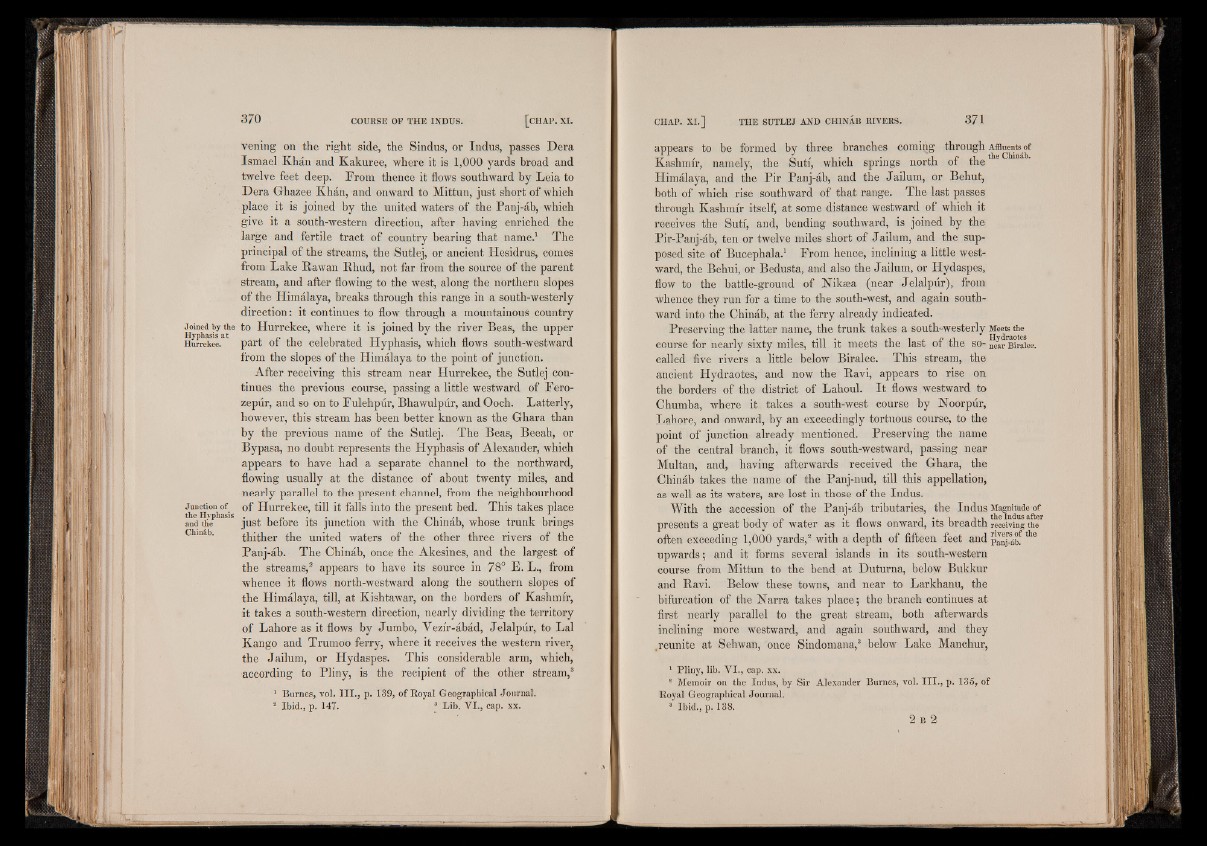
Joined by the
Hyphasis at
Hurrekee.
Junction of
the Hyphasis
and the
Chinab.
veiling on the right side, the Sindus, or Indus, passes Dera
Ismael Khan and Kakuree, where it is 1,000 yards broad and
twelve feet deep. From thence it flows southward by Leia to
Dera Ghazee Khan, and onward to Mittun, just short of which
place it is joined by the united waters of the Panj-ab, which
give it a south-western direction, after having enriched the
large and fertile tract of country bearing that name.1 The
principal of the streams, the Sutlej, or ancient Hesidrus, comes
from Lake Rawan Rhud, not far from the source of the parent
stream, and after flowing to the west, along the northern slopes
of the Himalaya, breaks through this range in a south-westerly
direction: it continues to flow through a mountainous country
to Hurrekee, where it is joined by the river Beas, the upper
part of the celebrated Hyphasis, which flows south-westward
from the slopes of the Himalaya to the point of junction.
After receiving this stream near Hurrekee, the Sutlej continues
the previous course, passing a little westward of Fero-
zepur, and so on to Fulehpur, Bhawulpur, and Ooch. Latterly,
however, this stream has been better known as the Ghara than
by the previous name of the Sutlej. The Beas, Beeah, or
Bypasa, no doubt represents the Hyphasis of Alexander, which
appears to have had a separate channel to the northward,
flowing usually at the distance of about twenty miles, and
nearly parallel to the present channel, from the neighbourhood
of Hurrekee, till it falls into the present bed. This takes place
just before its junction with the Chinab, whose trunk brings
thither the united waters of the other three rivers of the
Panj-ab. The Chinab, once the Akesines, and the largest of
the streams,2 appears to have its source in 78° E. L., from
whence it flows north-westward along the southern slopes of
the Himalaya, till, at Kishtawar, on the borders of Kashmir,
it takes a south-western direction, nearly dividing the territory
of Lahore as it flows by Jumbo, Yezir-abad, Jelalpur, to Lai
Kango and Trumoo ferry, where it receives the western river,
the Jailum, or Hydaspes. This considerable arm, which,
according to Pliny, is the recipient of the other stream,3
1 Burnes, vol. I I I . , p. 139, of Boyal Geographical Journal.
8 Ibid., p. 147. 8 Lib. V I., cap. xx.
appears to be formed by three branches coming through Affluents of
Kashmir, namely, the Suti, which springs north of the
Himalaya, and the Pir Panj-ab, and the Jailum, or Behut,
both of which rise southward of that range. The last passes
through Kashmir itself, at some distance westward of which it
receives the Suti, and, bending southward, is joined by the
Pir-Panj-ab, ten or twelve miles short of Jailum, and the supposed
site of Bucephala.1 From hence, inclining a little westward,
the Behui, or Bedusta, and also the Jailum, or Hydaspes,
flow to the battle-ground of Nikeea (near Jelalpur), from
whence they run for a time to the south-west, and again southward
into the Chinab, at tbe ferry already indicated.
Preserving the latter name, the trunk takes a south-westerly Meets the
course for nearly sixty miles, till it meets the last of the so- near Biralee.
called five rivers a little below Biralee. This stream, the
ancient Hydraotes, and now the Ravi, appears to rise on
the borders of the district of Lahoul. It flows westward to
Chumba, where it takes a south-west course by Noorpur,
Lahore, and onward, by an exceedingly tortuous course, to the
point of junction already mentioned. Preserving the name
of the central branch, it flows south-westward, passing near
Multan, and, having afterwards received the Ghara, the
Chinab takes the name of the Panj-nud, till this appellation,
as well as its waters, are lost in those of the Indus.
With the accession of the Panj-ab tributaries, the Indus Magnitude of
, , n • n i ' i i i , i the Indus after presents a great body ot water as it nows onward, its breadth receiving the
often exceeding 1,000 yards,2 with a depth of fifteen feet and panpabf1116
upwards; and it forms several islands in its south-western
course from Mittun to the bend at Duturna, below Bukkur
and Ravi. Below these towns, and near to Larkhanu, the
bifurcation of the Karra takes place; the branch continues at
first nearly parallel to the great stream, both afterwards
inclining more westward, and again southward, and they
.reunite at Sehwan, once Sindomana,3 below Lake Manchur,
1 Pliny, lib. V I., cap. xx.
8 Memoir on the Indus, by Sir Alexander Burnes, vol. I I I . , p. 135, of
Boyal Geographical Journal.
8 Ibid., p. 138.
2 B 2